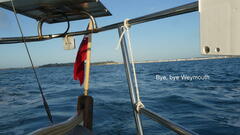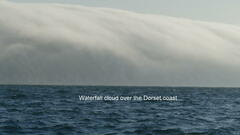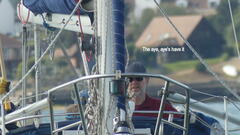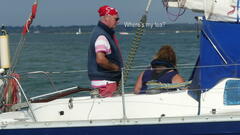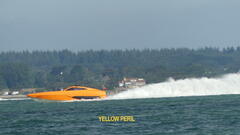It was my first cruise in Dulcibella since the delivery trip in May when with Duncan, my ‘volunteered’ crew, we motored for twenty two hours from Eastbourne in a 3 knot easterly! Despite my late entry Ray managed to get me a slot at Lymington for the Sunday night, as for Yarmouth on Saturday night; well you can’t book you just cross your fingers.
Its 15 Nm to St Albans Head from Weymouth and sailing eastward the tidal gate coincides with Dover LW which was around 10:30/11:00 on the Saturday, so with a light NE forecast for the morning this meant an early start. Boarding Friday evening I prepared the boat, planned the passage and transferred waypoints onto my plotter. Woken by my alarm I thought a cooked breakfast was the order of the day and I also prepared a flask of tea, sandwiches and snacks for the trip. By 07:30 I was warming the engine, removing sail covers and singling lines and as Crystella slid past I sprung the stern and slipped behind her into Weymouth bay. 08:00 and I set Main, Yankee and Staysail but kept the engine running as the wind had forgotten to get up, it was misty and we needed to maintain at least 5.5 knots to catch the tidal gate. Motor sailing eastward we had to wait an hour or so for the wind to arrive and then with engine off I was making 5.5 to 6.2 knots into 13/15 knots of north easterly.
Crystella called me to check on progress practicing variously Italian, double Dutch and Crystelian before I put them out of their misery by responding its ‘DULCIBELLA’. As we sailed it became clear from the CMG on my plotter that I was unlikely to make the inside passage at St Albans Head. I needed to point higher and I flattened the Main, hauled the traveller upwind to centre the boom and adjusted my Yankee and Staysail, the latter with care as it has the potential to backwind the main if over sheeted. My speed dropped to the mid fives and later Crystella told me they spotted me with ease as I was the yacht with the near horizontal mast! However the stream pushed me too far south east and approaching St Albans Head I realised I was going over the Ledge.
Quite suddenly my wind went! I was in the wind shadow of St Albans Head. Moments later I was in a maelstrom of breaking water and at barely 3 knots Dulcibella veered and plunged into the steep stationary waves. The autopilot went into limp mode and I started the engine to regain control. Green water cascaded over the deck as I pitched violently, burying the bow. Slowly I emerged on the other side of the headland, the wind returned and I could ease the revs until past Anvil Point. I had been careless; I should have had the engine on to make the inside passage and/or anticipated loosing the wind.
Clearing Durston I set the autopilot for my new waypoint, the Bell Fairway Buoy at the Needles fairway entrance, which I planned to pass to the north. Dulcibella romped off on a reach and I decided I needed drink and food. Leaning into the cockpit hatch to go below I saw reflections dancing on the saloon floor; what the.......WATER! A quick check indicated no boats nearby and I scrambled below. I dropped into water sloshing across the aft saloon floor; that meant my bilge was full and it’s a deep bilge! Then I spotted water pouring over the Heads door frame, aft and to starboard on my boat, and opening the door I was taken aback to see not only was the floor awash but the basin also was full; how on earth? Light bulb moment!
A few weeks back I had gone for a thrash out to the Shambles with a couple of friends. In a south westerly 15/17 Knots we close reached out on Starboard and going below to make tea I found water in the galley sink and some on the floor. I realised that when sharply heeled - deck edge immersion is 43 degrees - the sink, virtually on the water line at high heel angles, could back fill. Solution, close the stopcock when not in use or reef of course. This morning I had closed the galley stopcock but had not thought to do the same for the heads and my hard driving to make St Albans Head on Port tack combined with the violent trip over the Ledge had put the heads basin stopcock under water. I shut the stopcock and went topside to do some pumping. Returning below I bailed the basin and compartment into the bilge before once more doing some pumping. Job done, or so I thought.
Feeling rather chastened I had my tea and sandwiches whilst Dulcibella close reached across Poole Bay to the Needles Channel; it was a stunning sail with the log at one point indicating 6.7 Knots. Once past the Bell Fairway buoy and turning north I struggled to point and with the proximity of the Shingles Bank I motor sailed setting a course to clear first Warden Ledge then Fort Albert. As I eased round the Bell Sconce abeam Victoria Pier I called Yarmouth and after a short time holding outside the harbour I was escorted to a berth behind the other WSC yachts. I arrived at the harbour entrance at 14:00, not far behind Crystella. My passage worked out at 38 Nm at an average of 5.4 Knots and a maximum speed of 6.7 Knots. I was happy with that.
Declining a wander into town I repaired below to assess water damage. Well it was not good. The water had percolated inside the starboard saloon berth lockers, the bottom of the saloon seat and even the bottom book lockers were damp. Likewise the Heads locker was soaked and critically the bog rolls. All that heeling and plunging had allowed water to run up the inside of the hull exploiting the many bulkhead holes for cabling and hoses. Later going to lay out my sleeping bag in the forward cabin I found signs of water under both mattresses, not a lot but enough but luckily my sleeping bag and spare clothes were dry. I spent a fair time with a sponge and a bucket.
Our time in Yarmouth was blessed with outstanding weather, a pleasant walk to the other side of town to our dinner in a converted railway station and ample wine back on Crystella; it was nice to be sloshing back wine not water. It was decided that we would slip out early to view the Cowes to Torquay powerboat race, so foregoing too much imbibing on Crystella I hit the port saloon sack, the only dry one!
Morning arrived early but I managed to rise if not shine on a windless, balmy morning. Motoring toward Newtown Creek we soon heard the thunderous rumble of the Class 1 powerboats as they bounced and slammed down the North shore of the Solent; all over in fifteen minutes. We motored into Newtown and anchored in Clamerkin Lake. I draped my boat with damp seating, opened all my hatches and had a snooze. In due course the Ice Cream boat arrived; Rumrunner alone made it worthwhile for them. Nutcrackers crew went for a swim over to Crystella and returned saying they were tingling. I thought they were cold but it turned out they had been repelled by a Captain Nemo style attack from Crystella’s wind turbine shorting via the stanchions and boarding ladder.
Mid afternoon and I departed into a light breeze with a pleasant sail in the Solent before making my way to Lymington. My berth was next to a very large, very new, very smart Hanse and the very smart gentleman on board kindly climbed down his boarding ladder, the sides being over a metre above the pontoon, to help me. She was called BRIEF which seemed odd for a large boat until I noticed the defaced Ensign with white rolled script tied with red silk; a member of the Bar Yacht Club no less. I was glad the pontoon was between us. We retired to Crystella for drinks until realising it was too late for fish and chips. The others’ had to resort to a cold buffet whilst I made for my galley for steak, salad, new potatoes and wine; smug or what!
Dawn rose and we slipped for Weymouth at 06:00. I closed both basin stopcocks. Almost no wind but what there was came from the North East which was good. Motoring out to the Jack in the Basket I raised sail but kept the motor running as again we had a tidal gate to hit. At Hurst Castle Rumrunner cut north into Christchurch Bay looking for a downwind spinnaker run across to Anvil Point and St Albans. Crystella and I ran down the Needles Channel and as the wind came in with more north than east I bore up at the SW Shingles crossing the edge of the Shingles with four metres of water but with wind over tide there was the merest burbling from the waves. Crystella continued out westward before heading up to St Albans Head. My course was a close reach on about 250 degrees. The wind rose to 16/18 Knots and with wind over tide and full sail I surfed at over 8 knots. Due north I could see Rumrunner with main and spinnaker flying as she took full advantage of her downwind course. To the South West Crystella seemed to be enjoying a more leisurely pace with the advantage of a strong stream.
As I closed Durlston Head I noticed Rumrunner apparently circling with her spinnaker up; it looked odd. I suspected some issue but I was too far away to help and if they did have a problem then talking to me was not what they needed. It turned out that they had more wind than anticipated; talk to the first mate! In the meantime I found that I had made too much ground to windward despite what should have been a SW going stream out of Poole Bay. Suffice to say I found myself approaching Durlston Bay, much too far East and I had to ease sail to round the point for St Albans Head. By now the wind had gone further north causing intermittent wind shadow and I limped along, speed dropping to less than 4 knots on occasion until I was abeam St Albans Head and the last leg to Weymouth.
As I passed St Albans Head the wind rose and abeam Chapmans Pool it began gusting violently. I found myself reaching in 20 to 22 Knot winds and struggling to hold course. Easing the main was insufficient and the autopilot again went into limp mode. It was clear that I was way over canvassed. So, what to do? Reef the Mainsail, roll in the Yankee and or Staysail? Irrespective the Main had to be reduced, so reef or drop it? Either way I had to go to the mast so it seemed sensible to drop the Main and proceed under Yankee and Staysail. With an offshore wind I had ample sea room and I eased the mainsheet fully out, engaged engine and was then able to set the autopilot to hold us head to wind.
Main dropped and stacked I returned to my westward course with the two headsails driving her at an easy 5 to 6 knots. I was back in control. I ate my lunch, enjoyed the view and by 14:30 I was crossing Weymouth Bay and as I approached Weymouth Harbour started the engine, furled headsails and set the fenders. I moored up at 15:30, a passage of 42 Nm in 7.5 hours; an average of 5.5Kn. It had been an interesting trip.
So, what did I learn? Beware the wind shadow on headlands and anticipate strong gusts from steep cliffs. Check all non-essential seacocks are shut and get a bilge alarm! I have two manual bilge pumps but an automatic pump with alarm would have warned me much earlier. That Dulcibella is a fine seaworthy yacht, with an easy to handle sail configuration, a surprising turn of speed and comfortable motion for her size. Finally that WSC cruises offer lively company, good food and great sailing.
Submitted on 27th November 2021
